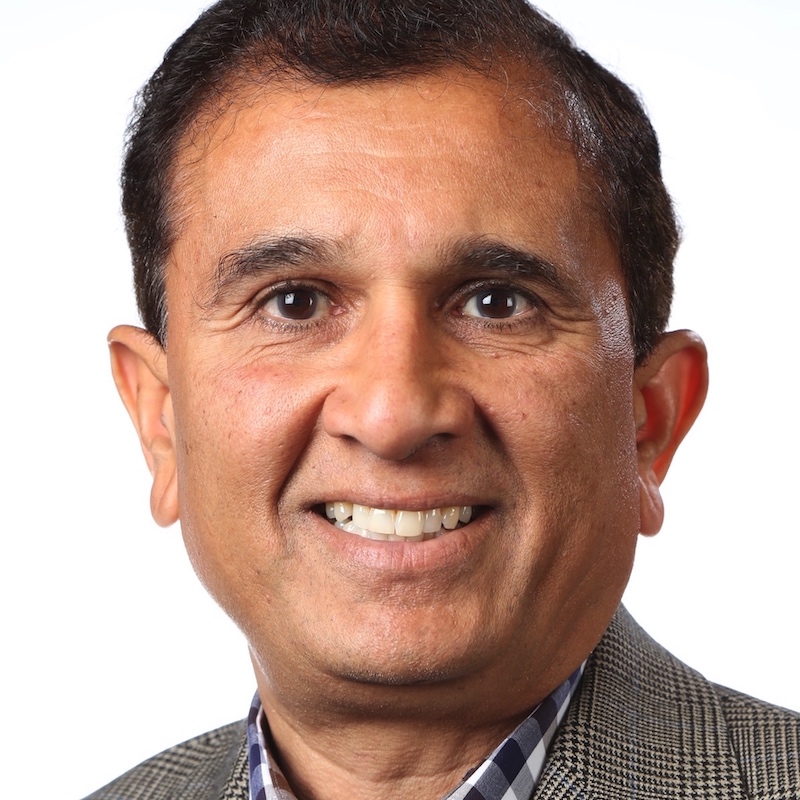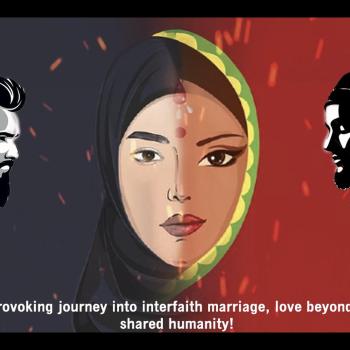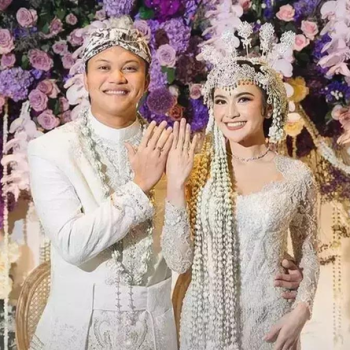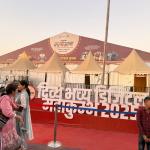Hindu-Muslim dating and its associated societal challenges were powerfully depicted in the play “When Gandhi and Mohammed Meet” by SETU. This thought-provoking performance was staged in March 2025 at the Mosesian Center for the Arts in Boston with a double cast of over two dozen talented actors.
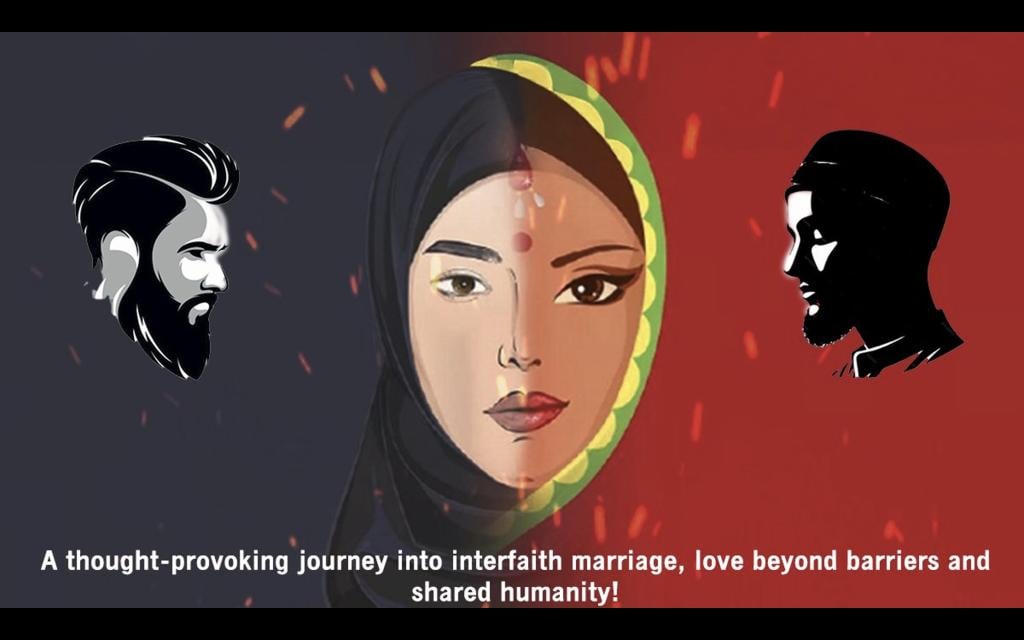
The play follows two interfaith couples—Nadia Khan (Muslim) and Neel Gandhi (Hindu) in London, and Smita Yadav (Hindu) and Mohammed Aslam (Muslim) in Delhi—who fall in love without foreseeing the storm their relationships would provoke within their families and communities. While they viewed love as natural and borderless, their families, shaped by deep-seated societal norms and historical grievances, saw these relationships as threats to their identity and honor.
This play is especially relevant for Hindu and Muslim young adults and their parents. While it may challenge certain beliefs and make viewers uncomfortable, it is a must-watch for anyone seeking to understand the real struggles of interfaith couples.
Pluralistic Messages in Scriptures
The play begins with an uplifting pluralistic message from the Upanishads, emphasizing the concept of One Self (Atman/Brahman) pervading all existence. A verse from the Bhagavad Gita (2:64) was also cited:
“But one who is free from attachment and aversion, and moves among sense objects with senses under control and self-discipline, attains divine grace.”
Similarly, Quran 49:13 was referenced:
“We have created you from a male and a female, and made you into nations and tribes so that you may know one another.”
These texts suggest a universalist approach, implying that Hindu-Muslim marriages need not be viewed as problematic from a religious standpoint.
The play further referenced a progressive interpretation from an Islamic scholar who argues that “the Quran does not prohibit Muslim women from marrying non-Muslim men.” (Muslim Wedding Officiant). However, it would have been valuable to also present counterarguments, such as those from Islamic jurisprudence, alongside direct Quranic references:
- Quran 2:221: “Do not marry polytheistic (ask if it means Hindu?) women until they believe. A believing slave woman is better than a polytheist, even if she pleases you.”
- Quran 60:11: “Do not maintain your marriage with unbelieving women.”
This debate over religious doctrine underscores the complex reality that many interfaith couples face, especially regarding expectations of conversion.
Hindu-Muslim Prejudices Toward Each Other
The play effectively highlighted the deep-seated stereotypes and fears that Hindu and Muslim communities harbor about each other, shaped by centuries of historical conflict.
From the Muslim perspective, Hindus were portrayed as idol-worshippers with superstitious beliefs, blindly reciting mantras for miracles. The Hindu practice of applying a tilak was mocked, and Sharia law was presented as the ultimate path to peace. Some characters also voiced the belief that interfaith children must follow Islam as they are considered Allah’s amanah (divine trust).
From the Hindu perspective, there was a strong fear that Muslims marry Hindus primarily for conversion and that interfaith children would be denied exposure to Hinduism, ultimately erasing their Hindu identity.
While these extreme views were held only by a few fanatical characters in the play, it was clear that their voices carried the most weight, ultimately shaping the fate of the interfaith couples—a tragic reflection of real-life societal pressures.
Advice to Parents: A Rational Approach to Interfaith Relationships
When parents hear the words, “Mom, I am in love with Mohammed, Neel, Nadia, or Smita,” they often react based on irrational fears and stereotypes. Instead of immediate opposition, a rational approach is recommended:
- Seek the truth, not assumptions – Meet the partner’s family, talk to their religious leaders (imam/pandit), and visit their place of worship.
- Engage in open dialogue – With mutual respect, ask questions about the stereotypes you’ve heard.
- Focus on fairness – Encourage your child and their partner to establish a Share and Respect with Equality approach—where both partners maintain 50-50 fairness in faith practices.
- Challenge inequality – Ask where equality isn’t achievable and discuss why not.
A thoughtful and informed approach will lead to better outcomes than outright rejection based on societal pressure. Ideally, interfaith couples should also ensure that no one is expected to fake a religious conversion (Fake Conversions) and that children are raised with an understanding of both faiths.
Parents’ Struggle: Fear of Society, Not Personal Belief
The play brilliantly depicted how parents themselves were often willing to accept their child’s interfaith love. However, they feared societal backlash—what their community, religious leaders, and extended family would think. Their concerns were rooted in external pressures rather than personal conviction.
This theme echoes casteist attitudes in interfaith marriages, as discussed in author’s previous article (Intermarriage as a New Category of Caste Systems). Overcoming centuries of ingrained prejudices will take time, but plays like SETU contribute to much-needed social change.
Communication Gap Between Generations
In the play, the first disclosure of an interfaith relationship immediately sparked conflict. Instead of engaging in a dialogue, parents and children became adversaries.
For example:
- When Nadia lost her job, her father was more concerned about what their imam would think than supporting his daughter.
- When Neel’s relationship ended, his parents immediately suggested an arranged marriage with a Hindu girl, disregarding his emotions.
Advice to Young Adults: Prepare Your Parents Gradually
For young adults in interfaith relationships, expect resistance. Instead of shocking your parents all at once, desensitize them over time:
- Start early – Talk about interfaith friendships and dating years before introducing your life partner.
- Add “spice” to stories – Share small experiences and let them react. Over time, they will become more open-minded.
- Build familiarity – When the time comes to introduce your partner, your parents will be more receptive.
Bollywood-Style Biases in the Play
Like PK (2014 movie) and other Bollywood productions, the play spent more time critiquing Hinduism than Islam. While issues in both religions were addressed, Hindu traditions were depicted more critically, and Christianity was idealized—despite it was not necessary and had no relevance to the story.
For example:
- Sharmila Tagore’s Muslim-(former)Hindu marriage was portrayed as a positive example, despite her conversion to Islam as necessary for Islamic Nikah and raising all three children as 100% Muslim without exposure to Hinduism.
- Muslims were shown as victims (Nadia’s suicide attempt), while Hindus were portrayed as perpetrators (the plot’s villain).
- Hindu gods (“Jai Shree Ram!”) and symbols were referenced in negative contexts, while Islamic elements such as Salat and “Allahu Akbar” were never critiqued.
While a critical analysis of the play may reveal nuanced portrayals and potential biases, most viewers will primarily appreciate the outstanding performances of the talented cast and the thought-provoking messages woven into the narrative. The play effectively highlights crucial social issues, making it both an engaging and enlightening experience for audiences. Overall, it was an enjoyable and impactful production.
Final Thoughts: A Must-Watch Play for Hindu-Muslim Families
“When Gandhi and Mohammed Meet” is a thought-provoking and much-needed play for today’s society. It boldly exposes the challenges faced by Hindu-Muslim couples and forces audiences to confront their biases.
The author strongly recommends all Hindu and Muslim young adults and parents watch this play to gain insight and foster dialogue on interfaith relationships.
Authors’ articles at Patheos that a Hindu-Muslim couple may find useful:
Love-Jihad: Use and misuse of the term
96% of Hindus expressed their unhappiness if their daughter marries to a Muslim
15 FAQs on Interfaith Marriage
Legal Implications in Interfaith Marriages
Hindu-Muslim Marriage: Nikah without Sahadah -Drs. Dilip Amin and Mike Mohamed Ghouse
Hindus Are Not Kafir –By Imam Iftekhar Hai
Hindus are believers –Dr. Mike Mohamed Ghouse
Status of Hindus in Muslim Majority country, Malaysia
Indonesia’s Ban on Interfaith Marriages: A Blow to Religious Freedom
JD Vance and Usha Chilukuri’s Marriage of Religious Equality
Intermarriage as a New Category of CASTE Systems
Idol-worshiper: Who Is and Who Is Not?
Circumcision: Science, Faith or Superstition?
10 Keys to a Successful Interfaith Marriage
Authors books
Interfaith Marriage: Share and Respect with Equality (2017)
In Malayalam language: Interfaith Marriage: Share and Respect with Equality (Feb 2025)
Hindu-Muslim Marriage: Difficulties and Reconciliations (Nov 2023)
In Hindi language: Hindu-Muslim Shaadi: Samasyayen Aur Samadhan (Mar 2023)
Hindu Vivaha Samskara (2011, coauthor)


